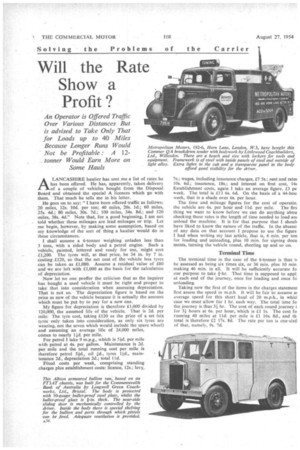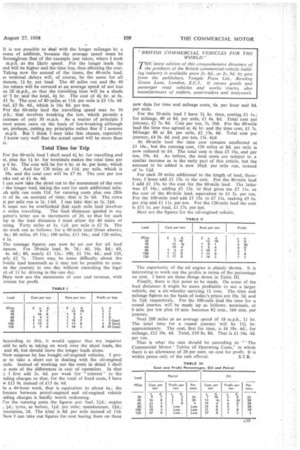Will the Rate Show a Profit ?
Page 62

Page 65

If you've noticed an error in this article please click here to report it so we can fix it.
An Operator is Offered Traffic Over Various Distances But is advised to Take Only That for Loads up to 40 Miles Because Longer Runs Would Not be Profitable. A 12Milner Would Earn More on
Some Hauls
ALANCASHIRE haulier has sent me a list of rates he has been offered. He has, apparently, taken delivery of a couple of vehicles bought from the Disposal Board and obtained the special A licences which go with them. That much he tells me in his letter.
He goes on to say: "I have been offered traffic as follows: 20 miles, 12s. 10d. per ton; 40 miles, 20s. id.; 60 miles, 25s. 4d.; 80 •miles, 30s. 7d.; 100 miles, 34s. 8d.; and 120 miles, 38s, 4d." Note that, for a good beginning, I am not told whether these mileages are lead mileages or trip. Let me begin, however, by making some assumption, based on my knowledge of the sort of thing a haulier would do in these circumstances.
I shall assume a 6-tonner weighing unladen less than 3 tons, with a sided body and a petrol engine. Such a vehicle, painted, lettered and ready for use, -might cost £1,200. The tyres will, at that price, be 34 in. by 7 in. oosting.£120, so that the net cost of the vehicle less tyres can be taken as £1,080. Assume a residual value of 180 arid we are left with 0,000 as the basis for the calculation of depreciation.
Now let no one proffer the criticism that as the inquirer has bought a used vehicle it must be right and proper to take that into consideration when assessing depreciation. That is not so. The depreciation figure is based on the price as new of the vehicle because it is actually the amount which /mist be put by to pay for a new one.
My figure for depreciation is therefore £1,000 divided by 120,000, the assumed life of the vehicle. That is 2d. per mile. The tyre cost, taking 1.120 as the price of a set (six tyres only taken into consideration, as only six tyres are wearing, not the seven which would include the spare wheel) and assuming an average life of 24,000 miles, comes to nearly lid. Or mile.
For petrol I take 9 m.p.g., which is 51d, per mile with petrol at 4s. per gallon. Maintenance is 2d, per mite and the total running cost per mile is therefore petrol na., oil id., tyres Ild., maintenance 2d., depreciation 2d.; total I Id.
Fixed costs per week, comprising standing charges plus establishment costs: licence, 12s.; levy,
7s,; wages, including insurance charges, £7 5s.; rent and rates 10s. 6d.; insurance, 18s.; and interest on first cost, 14s Establishment • costs, again I take an average figure, £.3 pc week. The total is £13 6s, 6d. On the basis of a 44-hou week, that is a shade over 6s. per hour.
The time and mileage figures for the cost of operatin; the vehicle are 6s. per hour and lid. per mile. The firs thing we want to know before we can do anything abou checking these rates is the length of time needed to load am unload the machine. It is for that purpose that I shmth have liked to know the nature of the traffic. In the absenc. of any data on that account I propose to use the figure 1 had when writing my last article, that is, 6 min. per ton for loading and unloading, plus 10 min, for signing duct' ments, turning the vehicle round, sheeting up and so on.
Terminal Tune
The terminal time in the case of the 6-tanner is thus t4 be assessed as being six times six, or 36 min. plus 10 min. making 46 min. in all. It will be sufficiently accurate fo our purpose to take I-hr. That time is supposed to appl: at each end of the journey, once for loading and once fo unloading.
Taking now the first of the items in the charges statemeni first assess the speed in m.p.h. It will be fair to assume ai average speed for this short haul of 20 m.p.h., in whicl ease we must allow for 1 hr. each way. The total time fo the journey is thus 31 hr. The cost of each round journey i for 31 hours at 6s. per hour, which is £1 Is. The cost fo running 40 miles at lid, per mile is £1 16s. 8d., and tb. total is therefore 1.2 17s. 8d. The rate per ton is one-sixt1 of that, namely, 9s. 7d.
It is not possible to deal with the longer mileages by a ocess of addition, because the average speed must be Terentifrom that of the example just taken, where I took m.p.h, as the likely speed. For the longer leads the eed will be higher and the time less, thus affecting the cost. Taking now the second of the items, the 40-mile lead.
m terminal delays will, of course, be the same for all ;tances, 11 hr. per load. The 40 miles out and the 40 les return will be covered at an average speed of not less an 26 m.p.h., so that the travelling time will be a shade er '3 hr. and the total, 4/ hr. The cost of 4/ hr. at 6s. £1 7s. The -cost of 80 miles at 11d, per mile is £3 13s. 4d. ital, £5 Os, 4d., which is 16s. 8d. per ton.
For the 60-mile lead the travelling speed may he 30 p.h.; that involves breaking the law, which permits a iximum of only 30 rn.ph. As a matter of principle I nnot assess rates on the basis of law-breaking although tin, perhaps, cutting my principles rather fine if I assume m.p.h.. But I think I may take that chance, especially know very well that the actual speed will be more than It.
Total Time for Trip For the 60-mile lead I shall need 41 ht. for travelling and tt, plus the l hr. for terminals makes the total time per
p 6 hr. The cost will, be for 6 hr. at 6s. per hour, which £1 I6s. And for 126 Miles at 11d, per mile, which is 10s. and the total cost will be 17 6s. The cost per ton >As out at £1 4s. 4d.
[can now take the short cut to the assessment ofthe cost r the longer lead;taking the cost for each additional mile. ch mile run costs 11d. for running costs plus one 28th rt of 6s. on account of time; that iS 2s: 6d. The extra st per mile run is ls. 1.6d.. f can take that as Is, 10. It must not be overlooked that each mile lead involves o miles travelling. The lead distances tjtioted in my prirer's letter are in increments of 20, so that for each np in the lead distances 1 must allow for 40 miles of aning. Forty miles at is. lid. per Mile is £2 5s. The -As work out as follows: for a 60-mile lead (from above), 6s.; 80 miles, £9 its:; 100 miles, LII 16s.; and 120 miles, 4 Is.
The tonnage figures can now be set out for all lead .tances. For 20-mile lead, 9s. 7d.; 40, 16s. 8d.; 60, 4s. 4d.; 80, nearly £1 12s.; 100, Li '19s. 4d.: and 120, any £2 7s: There may be some difficulty about the D-mile lead inasmuch as it may not be possible to corn:te the journey in one day without exceeding the legal tit of 11 hr. driving in the one day.
Here now are the statements of cost and revenue, with avision for profit.
According to this, it would appear that my inquirer add be safe in taking on work over the short leads, the and 40, but should leave the longer leads alone.
Now suppose he has bought oil-engined vehicles. I prose to take a short cut in dealing with the oil-engined aide. Instead of working out the costs in detail I shall :e note of the differences in cost of operation. In that y I first add 2s. 6d. per week for " interest " to the nding charges so that, for the total of fixed costs, I have w £13 9s. instead of £13 6s. 6d.
in a 44-hour week, that is equivalent to about 6s.; the Terence between petrol-engined and oil-engined vehicle nding charges is hardly worth reckoning.
For the running costs the figures are: fuel, 21c1.; engine , id.; tyres, as before, lid. per mile; maintenance, areciation, 2d. The total is 84. per mile instead of lid. Now I can take out figures for cost basing them on these new data for time and mileage costs, 6s. per hour and 8d. per mile.
For the 20-mile lead I have 31 hr. time, costing El Is.; for mileage, 40 at 8d. per mile, £1 6s. 8d. Total cost per journey, £2 7s. 8d. Cost per ton, 7s. 10d. For the 40-mile lead the time was agreed at 41 hr. and the time cost, £1 7s. Mileage: 80 at 8d. per mile, £2 .13s. 4d, Total cost per journey, £4 Os. 4d. and, per ton, 13s. 4/d.
At 60-mile lead the time cost remains unaffected at 11 16s., but the running cost, 120 miles at 8d. per mile is now reduced to £4. The total cost is thus £5 16s, and per ton, 19s. 4d. As before, the lead costs are subject to a similar increase as in the early part of this article, but the amount to be added is now 10d. per' mile run, instead of Is. lid.
For each 20 miles additional to the length of lead, therefore, r must add £1 15s. to the cost. For the 80-mile lead
I add £1 15s. to the cost for the 60-mile lead. The latter was 1.5 16s.; adding £1 15s. to that gives me £7 Ils. as the cost of the 80-mile lead, equivalent to £1 5s. per ton. For the 100-mile lead add Li 15s. to £7 Ils. making £9 6s. per trip and £1 .11s. per ton. Fo.r the .120-mile lead the cost is El 1 ls.'per load, £117s. per. ton,
Here are the figures for the oil-engined vehicle.
The superiority of the oil engine is shown. It is
interesting to work out the profits in terms of the percentage on cost. I have set these things down in Table III.
Finally, there is this point to be made. On some of the lead distances itmight be more profitable to use a larger vehicle, say a six-wheeler carrying 12 tons. The time and mileage figures on the basis of today's prices are 10s. 3d. and Is. 314. respectively. For the 100-mile lead the time for a round journey will be made up as follows; •terminals, at
6 min. per ton plus 10 min. becomes 82 min., 164 min. per journey.
Next 200 miles at an average speed of 18 m.p.h., 11 hr. The total time for a round journey 'Will be 13/ hr. approximately. The cost, first for time, is 16 18s. 4d.; for mileage, £12 10s. 4d, Total, £19 8s. 8d. That is £1 14s. 4d. per ton.
That is what the rate should be according to " The Commercial Motor' Tables of Operating Costs," in which there is an allowance of 20 per cent. on cost for profit. It is
within pence only of the rate offered. S.T.R.




























































































